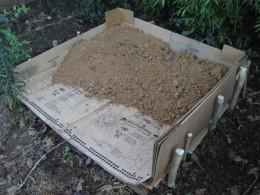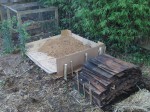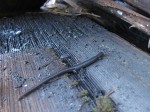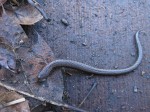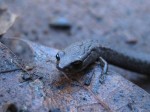
Garden Log (what I did):
1. Made a 3-sided cardboard box for storing adobe (clay) soil.
You, the Habitat Gardener (reflections):
1. Time to get to some serious gardening in during these wonderful warm days of winter. First that comes to mind, after the long list of jobs that I am procrastinating, is to get some better soil on hand. Many ways for me to improve our garden’s soil — fetching oak leaves from the curb, collecting fallen leaves and rotten fruit from under a neighbor’s persimmon tree, hauling a truckload of free horse manure, or buying a truckload of mycellium-rich compost from a mushroom farmer. Those are just a few ways that are currently easiest for me. As with the infinite wonder of soil, how to improve it is also infinite. Yes, I do like to gravitate to the FREE, or at least fairly inexpensive, sources of material.
I will want to empty the 55-gallon plastic drums that I use for collecting soil/manure/compost material. Right now, half of those bins/barrels are filled with excavated adobe soil from the depths of Salamander Resort (see Watered Clay). What to do with the adobe? Lucky for me, we have some extra room next to our compost bins. We’ll pile the adobe there and feed the compost with it over the years. Adobe by itself is a tough sell for plants. But mix that adobe into already rich compost and wala!, you have a superb mix of soil tilth (consistency) and nutrition. A back-the-truck-up visit to our town’s cardboard dumpster and gathering some pruned shrub limbs is all the supplies we’ll need to create an outdoor storage bin for the adobe.
Clearing a space in this out-of-the-way part of the yard proved interesting. First off, you should know that the immediate yard was reclaimed by ivy, thick ivy. Sheet mulching a couple of years ago has proven effective in keeping down the ivy. And when clearing away the stack of roofing shakes that were next to the compost, I found out just what a great habitat the back yard is. Salamander Haven! Sheets and sheets of moist cardboard covered under decaying straw — the black bellied slender salamanders (Batrachoseps nigriventris) of our neighborhood have thrived here. Dozens were under and in the small roofing shake pile that I re-organized to make room for the adobe bin.
I wanted a flat surface to create the cardboard adobe bin/box. Getting the surface flat mostly meant sorting through some ivy vines (no sheet mulching here) and the crumbly wood shakes that were at the bottom of the pile. Lots of salamanders to avoid hurting, too. After piking out the shakes worth saving, I made a pile of the old scraps and some rich soil to house some of the salamanders not insulted out of their habitat. All that was then covered with the thickest cardboard to form the bottom of the bin.
True, perhaps a very rough day for some relocated salamanders, that is, those that went off into the surrounding vegetation to escape the upheaval of their Roofing Tile Palace. But, also a good day for those that will stay in the immediate area. Not only do those local salamanders get new accommodations in a well-stacked highrise apartment complex, but also they get yearly renewable membership to Anita’s Adobe Assembly. Actually, the salamanders will probably not be too interested in the adobe clay pile itself. My guess is, though, that the moist underneath and sides of the clay pile will be this summer’s, and many summers to come, happenin’ place if you’re a sally. The clay pile will keep cool and moist long after the surrounding soil dries up from warmer weather. That moisture-laden microenvironment will attract much food and shelter for the salamanders. So, salamanders, sorry for the unannounced housing move — hope the neighborhood improvements make up for any inconvenience.
Adobe anyone?
…………………………………………………………Tony

